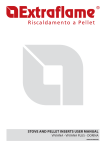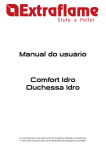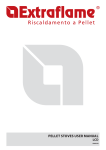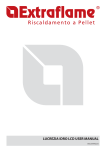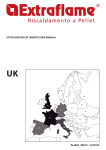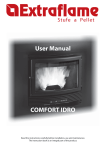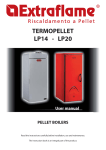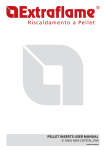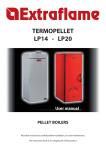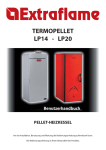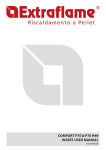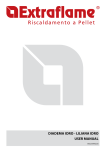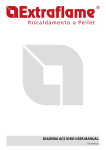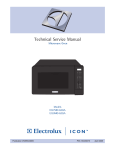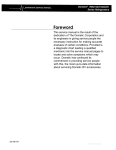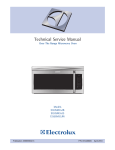Download Extraflame Duchessa User manual
Transcript
Stufe a Pellet User manual Comfort Idro Duchessa Idro Read the instructions carefully before installation, use and maintenance. The instruction book is an integral part of the product. 2 INDEX WARNINGS AND SAFETY DEVICES ............................. 4 TECHNICAL FEATURES .............................................. 5 COMFORT IDRO TEMPLATE ....................................... 6 DUCHESSA IDRO TEMPLATE ...................................... 8 WHAT IS THE PELLET? ............................................. 10 PELLET STORAGE ........................................................................ 10 .......................................................................... 10 ......................... 11 TEMPLATE WITH LATERAL FEEDING SUPPORT ............................... 12 PELLET FRONT FEEDING OPTIONAL KIT ....................................... 13 TEMPLATE WITH FRONT FEEDING SUPPORT.................................. 15 STANDARD SUPPLY .............................................................. 15 SAFETY DEVICES .................................................... 16 FLUE EXHAUST BREAKAGE ............................................................. 16 PELLET FEED MOTOR STOP ............................................................. 16 DOOR MICRO SWITCH ................................................................... 16 MICRO BLOCKING INSERT ............................................................... 16 TEMPORARY POWER CUT ............................................................... 16 ELECTRIC SAFETY ........................................................................ 16 FLUE EXHAUST SAFETY DEVICE ....................................................... 16 85°C PELLET TANK BULB .............................................................. 16 WATER OVERHEATING SAFETY VIA 100° C BULB ................................. 16 MINIMUM AND MAXIMUM PRESSURE PRESSURE SWITCH .......................... 16 INSTALLATION AND SAFETY DEVICES ................................................. 17 SAFETY DEVICES FOR CLOSED VESSEL SYSTEM...................................... 17 DISTANCES OF SAFETY DEVICES ACCORDING TO THE STANDARD ............... 17 COMFORT IDRO SAFETY DEVICE IMAGES ............................................ 18 PELLET FEEDING LATERAL PELLET FEEDING SUPPORT OPTIONAL KIT TABLE OF THE DEVICES FOR CLOSED VESSEL SYSTEMS PRESENT AND NOT PRESENT IN THE PRODUCT ......................................................................... 18 DUCHESSA IDRO SAFETY DEVICE IMAGES ........................................... 19 ASSEMBLY AND INSTALLATION INSTRUCTIONS ........ 20 GLOSSARY................................................................................ 20 INSTALLATION............................................................................ 20 ALLOWED INSTALLATIONS ............................................................. 20 INSTALLATIONS NOT ALLOWED ....................................................... 20 CONNECTION TO THE SMOKE EVACUATION SYSTEM .. 21 SMOKE CHANNEL OR CONNECTIONS ......................................... 21 CHIMNEY OR INDIVIDUAL FLUE ............................................... 21 CONNECTION OF THE APPLIANCE TO THE FLUE .......................... 22 POSITIONING ............................................................................. 25 ASSEMBLY ON EXISTING BASE ................................................. 25 ASSEMBLY WITH SUPPORT AND FEED KIT ................................... 26 INSTALLATION OF THE HYDRAULIC PART ............................................ 27 NO COVERING PRESENT ........................................................ 27 ALREADY EXISTING COVERING................................................. 27 AIR CIRCULATION PIPES ................................................................ 29 HYDRAULIC SYSTEM ............................................... 31 PRODUCT FUNCTIONALITY ..................................... 32 ........................................................................ 32 CURRENT DAY AND TIME ADJUSTMENT .............................................. 32 IGNITION .................................................................................. 32 PUMP FUNCTIONING .................................................................... 32 SWITCH-OFF ............................................................................. 32 THE REMOTE CONTROL ........................................... 33 ADDITIONAL ROOM THERMOSTAT ........................... 33 INSTALLATION ........................................................................... 33 INDICATOR ................................................................................ 33 COMFORT IDRO ......................................................................... 33 DUCHESSA IDRO:........................................................................ 33 USER PARAMETERS ................................................ 34 WEEKLY PROGRAMMER ................................................................ 34 COMFORT IDRO CLEANING - DUCHESSA IDRO .......... 37 BURN POT CLEANING ................................................................... 37 USING THE SCRAPERS .................................................................. 37 CLEANING TRAYS/ASH DRAWER ...................................................... 37 CLEANING HEAT EXCHANGER (COMFORT IDRO) ................................... 38 DOOR, ASH DRAWER AND BURN POT GASKETS .................................... 38 CONNECTION TO THE FLUE ............................................................ 38 DUCHESSA IDRO CLEANING .................................... 39 BURN POT CLEANING ......................................................... 39 DOOR, ASH DRAWER AND BURN POT GASKETS................ 40 CONNECTION TO THE FLUE ............................................................ 40 PRODUCT DISPLAY TABLES ..................................... 41 WARRANTY CONDITION.......................................... 43 CONTROL BOARD ............................. 22 WINDPROOF ..................................................................... 22 CONNECTION TO EXTERNAL AIR INLETS ............................................. 23 SAFETY RECOMMENDATIONS .......................................................... 23 NATIONAL, REGIONAL, PROVINCIAL AND TOWN COUNCIL REGULATIONS ...... 24 HOT AIR DUCTING .................................................. 24 DIVINA PLUS ............................................................................ 24 TOSCA PLUS .............................................................................. 24 COMFORT IDRO INSTALLATION ............................... 25 EVACUATION OF THE COMBUSTION PRODUCTS 3 WARNINGS AND SAFETY DEVICES The stoves produced by our establishment are built with attention to the individual components in a way to protect both the user and the installer from any accidents. It is therefore recommended that after any intervention on the product, that authorised staff pay particular attention to the electric connections, especially the stripped parts of the wires. These must not escape from the terminal board in any situation, thus preventing possible contact with the live parts of the wire. Installation must be carried out by authorised staff, who must provide the buyer with a declaration of conformity for the system and will assume full responsibility for final installation and as a consequence the correct functioning of the installed product. It is necessary to bear in mind all laws and national, regional, provincial and town council Standards present in the country the appliance has been installed. Extraflame S.p.A. cannot be held responsible for the failure to comply with such precautions. The instruction manual is an integral part of the product: make sure that it always accompanies the appliance, even if transferred to other owners or user or is transferred to another place. If it is damaged or lost,request another copy from the area technician. This stove must be destined for the use for which it has been expressly realised. The manufacturer is exempt from any liability, contractual and extracontractual, for injury/damage caused to persons/animals and objects, due to installation, adjustment and maintenance errors and improper use. After the packaging has been removed, check the integrity and completeness of the contents. If this does not comply, contact the dealer where the appliance was purchased. All electric components that make up the stove must be replaced with original spare parts exclusively by an authorised after-sales centre, thus guaranteeing correct functioning. parts of the body are wet or humid. The safety and adjustment devices must not be modified without the authorisation or indications of the manufacturer. Do not pull, disconnect, twist electric cables leaving the stove, even if disconnected from the electric power supply mains. Do not close or reduce the dimensions of the airing vents in the place of installation. The airing vents are indispensable for correct combustion. Do not leave the packaging elements within reach of children or unassisted disabled persons. The hearth door must always be closed during normal functioning of the product. Avoid direct contact with parts of the appliance that tend to heat up during functioning. Check for the presence of any obstructions before switching the appliance on following a prolonged standstill period. The stove has been designed to function in any climatic condition (also critical). In particularly adverse conditions (strong wind, freezing) safety systems may intervene that switch the stove off. If this occurs, contact the technical after-sales service and always disable the safety system. If the flue should catch fire, be equipped with suitable systems for suffocating the flames or request help from the fire service. MAJOLICAS: Our majolicas are top quality artisan products and as such can have micro-dots, crackles and chromatic imperfections. These features highlight their valuable nature. Due to their different dilation coefficient, enamel and majolica produce crackling, which demonstrate their effective authenticity. To clean the majolicas, it is recommended to use a soft, dry cloth. If a detergent or liquid is used, the latter could penetrate inside the crackles, highlighting the same. The stove must be serviced at least once a year, programming it in advance with the technical after-sales service. Nota bene: In case of thermo product or boiler, the product or system venting is not covered by the warranty. For safety reasons, remember that: The stove must not be used by children or unassisted disabled persons. Do not touch the stove when you are barefoot or when 4 WARNINGS AND SAFETY DEVICES TECHNICAL FEATURES FEATURES Weight Height Width Depth Flue exhaust pipe diameter Air intake pipe diameter Max. heating volume Max. global heat output Max. useful heat output - useful output power to the air - useful output power to the water Minimum global heat output Min. useful heat output - useful output power to the air - useful output power to the water Max. hourly fuel consumption Min. hourly fuel consumption Feed-box capacity Recommended flue draught Nominal electric output * Appliance electrical power * Nominal voltage Nominal frequency Water inlet/outlet pipe diameter Automatic exhaust pipe diameter Pump head Heat exchanger fluid content Max. working water pressure accepted kg mm mm mm mm mm m3 kW kW kW kW kW kW kW kW kg/h kg/h kg Pa W W V Hz “ “ m l bar COMFORT IDRO DUCHESSA IDRO DUCHESSA IDRO STEEL 157 777 663 781 80 50 14.0 12.6 4.6 8 4.0 3.8 1.3 2.5 2.8 0.8 ~ 22 ~ 10 300 300 230 50 3/4 1/2 7 2.5 170 1034 538 543 80 50 13.1 12.0 1.2 10.8 3.9 3.6 0.6 3.0 2.8 0.8 ~ 20 ~ 10 300 300 230 50 3/4 1/2 5 13 2.5 158 1034 538 543 80 50 13.1 12.0 1.2 10.8 3.9 3.6 0.6 3.0 2.8 0.8 ~ 20 ~ 10 300 300 230 50 3/4 1/2 5 13 2.5 The tank capacity depends on the type of pellet used. Tests performed using wooden pellets as fuel, certified according to ÖNORM M7135 DIN PLUS. The data given above is indicative and not binding. The manufacturer reserves the right to make any modifications in order to improve product performance. * The electric power of the appliance indicates the total electric absorption of the components present inside the product as per standard. The nominal power is the maximum power value which the appliance can absorb also considering the installation of the various additional devices. TECHNICAL FEATURES 5 COMFORT IDRO TEMPLATE CONDOTTO ASPIRAZIONE ARIA AIR INTAKE PIPE CONDUIT ASPIRATION AIR A Ø 50 mm ZULUFTANSAUGLEITUNG CONDUCTO DE ASPIRACIÓN DE AIRE CONDUTA DE ASPIRAÇÃO DE AR CONDOTTO ESPULSIONE FUMI FLUE GAS EXHAUST PIPE CONDUIT EXPULSION FUMÉES B Ø 80 mm RAUCHABZUGSLEITUNG CONDUCTO DE EXPULSIÓN DE HUMOS CONDUTA DE EXPULSÃO DE FUMOS MANDATA/USCITA CALDAIA BOILER FLOW OUTLET ALLER/SORTIER CHAUDIERE C 3/4 “ KESSEL-VORLAUF/AUSGANG IDA/SALIDA DE LA CALDERA FORNECIMENTO/SAÍDA DA CALDEIRA RITORNO/INGRESSO CALDAIA BOILER RETURN/INLET RETOUR/ENTREE CHAUDIERE D 3/4 “ KESSEL-RÜCKLAUF/EINGANG RETORNO/ENTRADA DE LA CALDERA RETORNO/ENTRADA DA CALDEIRA SCARICO SICUREZZA 3 BAR 3 BAR SAFETY DRAIN DÉCHARGE SÉCURITÉ 3 BARS E 1/2” SICHERHEITSAUSLASS 3 BAR DESCARGA DE SEGURIDAD 3 BAR DESCARGA DE SEGURANÇA 3 BAR 6 COMFORT IDRO TEMPLATE C 800 D E 777 360 663 56 645 59 74 781 275 223 37 142 42 A 30 97 777 664 B 106 D C E C COMFORT IDRO TEMPLATE D 7 DUCHESSA IDRO TEMPLATE CONDOTTO ASPIRAZIONE ARIA AIR INTAKE PIPE A CONDUIT ASPIRATION AIR Ø 50 mm ZULUFTANSAUGLEITUNG CONDUCTO DE ASPIRACIÓN DE AIRE CONDUTA DE ASPIRAÇÃO DE AR CONDOTTO ESPULSIONE FUMI FLUE GAS EXHAUST PIPE B CONDUIT EXPULSION FUMÉES Ø 80 mm RAUCHABZUGSLEITUNG CONDUCTO DE EXPULSIÓN DE HUMOS CONDUTA DE EXPULSÃO DE FUMOS MANDATA/USCITA CALDAIA BOILER FLOW OUTLET C ALLER/SORTIER CHAUDIERE 3/4 “ KESSEL - VORLAUF/AUSGANG IDA/SALIDA DE LA CALDERA FORNECIMENTO/SAÍDA DA CALDEIRA RITORNO/INGRESSO CALDAIA BOILER RETURN/INLET D RETOUR/ENTREE CHAUDIERE 3/4 “ KESSEL-RÜCKLAUF/EINGANG RETORNO/ENTRADA DE LA CALDERA RETORNO/ENTRADA DA CALDEIRA SCARICO SICUREZZA 3 BAR 3 BAR SAFETY DRAIN E DÉCHARGE SÉCURITÉ 3 BARS 1/2” SICHERHEITSAUSLASS 3 BAR DESCARGA DE SEGURIDAD 3 BAR DESCARGA DE SEGURANÇA 3 BAR SCARICO ARIA CALDAIA DRAINAGE G RUBINET DE DECHARGE AIR 3/4” KESSELENTLÜFTUNGSHAHN DESCARGA DE AIRE CALDERA DESCARGA DE AR DA CALDEIRA 8 DUCHESSA IDRO TEMPLATE 538 1034 545 31 C 34 B A D 118 203 88 168 868 54 59 47 E G 52 63 DUCHESSA IDRO TEMPLATE 9 WHAT IS THE PELLET? Pellets are realised by subjecting wood shavings i.e. the rejects of pure wood (without paint) sawmill, carpenter products and products from other activities connected to working and transforming wood, to very high pressures. This type of fuel is absolutely ecological as no glues are used to hold it together. In fact, the compactness of the pellets is guaranteed through time by a natural substance that is found in wood: lignin. As well as being an ecological fuel, as wood residues are made the most of, the pellet also has technical advantages. Pellet density is about 650 kg/m3 and water content is equal to 8% of its weight. For this reason the pellet does not have to be seasoned in order to obtain a sufficiently adequate heat yield. The pellet used must comply with the features described by the Standard: Ö-Norm M 7135 DIN plus 51731 UNI CEN/TS 14961 Extraflame recommends the use of pellets with a diameter of 6mm with its products. WARNINGS!!! THE USE OF EXPIRED PELLETS OR ANY OTHER MATERIAL DAMAGES THE FUNCTIONS OF YOUR STOVE AND CAN DETERMINE THE INVALIDITY OF THE WARRANTY AND THE ANNEXED RESPONSIBILITY OF THE MANUFACTURER. PELLET STORAGE To guarantee combustion without problems, the pellets must be kept in a dry place. PELLET FEEDING Use the most congenial system to the type of installation made to feed the pellets: DESCRIPTION OF THE KIT MODELS OPTIONAL SUPPORT KIT WITH LATERAL PELLET COMFORT MAXI FEEDING (9278207) COMFORT PLUS COMFORT IDRO OPTIONAL SUPPORT KIT WITH LATERAL PELLET COMFORT MINI - COMFORT MINI CRYSTAL FEEDING (9278214) COMFORT P80 COMFORT IDRO FRONT PELLET FEEDING OPTIONAL KIT (9278261) COMFORT IDRO FRONT PELLET FEEDING OPTIONAL KIT (9278262) COMFORT PLUS COMFORT PLUS 10 WHAT IS THE PELLET? LATERAL PELLET FEEDING SUPPORT OPTIONAL KIT If installation has been performed using this optional kit, the insert can be extracted or, more comfortably, use the appropriate lateral chute whenever a relevant opening has been made in the covering of the appliance. For increased clarity regarding the templates, please consult the relative templates manual, which can be downloaded from the site (see back of last page). figure 3.1 ATTENTION: THE MEASUREMENTS ARE INDICATIVE AS THE KIT CAN BE REGULATED. Extraflame reserves the right to vary the features and data given in this document at any time without forewarning, in order to improve its products. WHAT IS THE PELLET? 11 TEMPLATE WITH LATERAL FEEDING SUPPORT C D 800 A 716 777 664 360 97 ~1277 B 752 E *373 37 560 223 142 640 30 275 106 D 42 400 781 56 645 59 74 ~881 C 12 WHAT IS THE PELLET? PELLET FRONT FEEDING OPTIONAL KIT The use of this optional kit allows to feed the pellets into the feed-box from the front without extracting the flue, therefore without switching it off. FRONT UPPER FRAME figure 3.2 figure 3.3 figure 3.4 First, remove the front, upper frame by unhooking it from the 2 lateral frames: to do this, lift it by about 10 mm and then pull it towards yourself. The frame must be picked-up using protection for the hands as it could have overheated during functioning. Take the fire irons supplied, attach them to the 2 holes in the lower part of the cast iron grate and pull to maximum extension. Take the supplied Allen wrench, insert it into the relevant seat and turn in a clockwise direction until fully home. If this operation has been carried out correctly the drawer will be blocked and cannot be moved forwards or backwards. GRATE IN CAST IRON FIRE IRONS figure 3.5 INSERT TO ALLEN WRENCH ALLEN WRENCH figure 3.6 WHAT IS THE PELLET? figure 3.7 13 At this point, take the internal drawer and pull it towards yourself to maximum opening: carry out this SCRAPER operation with the aid of a common protection for the hands or an oven glove in order to prevent burns due to normal overheating of the metal parts during functioning of the appliance. Pour the pellet into the drawer and use the scraper to push it into the flue tank, making sure that it does not INTERNAL remain in the drawer. DRAWER figure 3.8 figure 3.9 figure 3.10 After having filled the feed-box, repeat the operations in the reverse order to make the product go back to its original state. During normal functioning the flue must always be as illustrated in the figure i.e. with the drawer completely closed. The front pellet loading drawer must only be open for the loading time in order to prevent product overheating. figure 3.11 14 WHAT IS THE PELLET? During normal functioning the flue must always be as illustrated in the figure i.e. with the drawer completely closed. The front pellet loading drawer must only be open for the loading time in order to prevent product overheating. TEMPLATE WITH FRONT FEEDING SUPPORT STANDARD SUPPLY D E 42 30 223 37 142 645 275 360 A 777 97 709 777 B 709 C 710 106 735 640 800 Installation of the insert with the standard supply envisions switch-off and extraction of the flue for every pellet feed. WHAT IS THE PELLET? 15 SAFETY DEVICES 85°C PELLET TANK BULB If there is overheating inside the feed-box this device blocks pellet feed motor functioning; restoration is FLUE EXHAUST BREAKAGE If the suction device stops, the electronic board manual and must be performed by an authorised technician. immediately blocks the pellet supply. The restoration of 85°C safety device is not under PELLET FEED MOTOR STOP warranty unless the after-sales centre can show If the motor reducer stops for any reason, the stove the presence of a faulty component. goes into alarm mode and the fumes motor continues WATER OVERHEATING SAFETY VIA 100° to function in order to expel all combustion gas until C BULB the minimum cooling level is reached. When the temperature of the water inside the DOOR MICRO SWITCH product is in proximity of 100°C, pellet feeding is When the stove door is opened, a safety micro blocked. If the bulb trips, restoration of the safety device is manual and must be performed by an switch blocks fuel feeding. authorised technician. MICRO BLOCKING INSERT The restoration of 100°C safety device is not In the "Comfort idro" product there is an end under warranty unless the after-sales centre can run micro switch that warns when the machine show the presence of a faulty component. is blocked in the running rails. If the micro switch detects that the insert is not suitably blocked, it MINIMUM AND MAXIMUM PRESSURE blocks the passage of electric current inside the PRESSURE SWITCH machine. A minimum and maximum pressure pressure switch is installed in series with the pellet motor electric NO IGNITION energy power supply. If the pressure in the system If a flame is not developed during the ignition phase, is below 0.6 bar, the electric energy power supply the appliance will go into no ignition alarm mode, is blocked to the pellet feed motor. If the pressure displaying “NO IGN”. in the system exceeds 2.5 bar, manual rearm of the pressure switch is triggered: restoration of the TEMPORARY POWER CUT safety device is manual and must be performed by If the power cut is less than 10 seconds, normal an authorised technician. stove functioning will continue when the current Attention: any presence of air in the system returns. If the power cut is longer than 10 seconds, could cause the minimum or maximum pressure the stove "black out" alarm will occur when the pressure switch to also intervene. If the minimum current returns, taking the product to complete pressure pressure switch intervenes blocking pellet cooling. When cooling has ended it will re-start in feed into the machine, alarms may occur connected automatic mode. to the lack of fuel. Attention: For regular functioning of the product the ELECTRIC SAFETY ideal system pressure must be calibrated at approx. The stove is protected against strong current 1.1 bar with cold system. Moreover, there must be no changes by a master fuse that is found in the rear air in the system. Extraflame recommends suitable part of the stove. (2.5A 250V Delayed). air vent circuit in the system. Any air venting FLUE EXHAUST SAFETY DEVICE operations from the system or the product is not An electronic pressure switch blocks stove covered by the warranty. functioning and takes it to alarm conditions. 16 SAFETY DEVICES DEVICES NOT IN THE LIST SAFETY DEVICES FOR CLOSED VESSEL During installation of the stove it is MANDATORY SYSTEM to adjust the plant using a manometer to display According to the UNI 10412-2 (2006) Standard in the water pressure and an automatic vent valve force in Italy, the closed plants must have: calibrated at 3 bar. Safety valve Pump control thermostat INSTALLATION AND SAFETY DEVICES Acoustic alarm activation thermostat The installation, relative system connections, Temperature indicator commissioning and inspection of correct functioning Pressure indicator must be carried out perfectly, in total compliance Acoustic alarm with Standards in force, both national, regional and Adjustment automatic circuit breaker switch municipal, as well as these instructions. Automatic circuit breaker switch (block For Italy, installation must be carried out by thermostat) professionally authorised staff (Ministerial Decree Circulation system dated 22.01.08 n°37). Expansion system* Extraflame S.p.A. declines all responsibility for Safety dissipation system incorporated with damages to objects and/or persons caused by the generator with thermal safety valve (selfthe system. activated), whenever the appliance does not have a temperature self-adjustment system DISTANCES OF SAFETY DEVICES ACCORDING TO THE STANDARD Component Distance Temperature safety sensors On the machine or not exceeding 30 cm Devices missing because not standard (see Not exceeding one metre, on the flow pipe following table) and the valve must be free from interceptions. The pressure upstream from the cooling circuit must be at least 1.5 bar. ATTENTION! THE COMFORT IDRO MODEL DOES Whenever the generators lack a device, those NOT HAVE EXPANSION VESSEL AND PUMP AS missing can be installed on the thermo product flow PER STANDARD pipe, within a distance no greater than 1m from the machine. The temperature safety sensors must be in place on the machine at a distance no greater than 30 cm from the flow connection. The domestic heating appliances with automatic feeding must: be equipped with a fuel block thermostat, or be equipped with a cooling circuit prepared by the manufacturer of the appliance. The cooling circuit must be activated by a heat safety valve such to guarantee that the limit temperature set by the Standard is not exceeded. Connection between the power supply unit SAFETY DEVICES 17 TABLE OF THE DEVICES FOR CLOSED VESSEL SYSTEMS PRESENT AND NOT PRESENT IN THE PRODUCT Safety valve COMFORT IDRO DUCHESSA IDRO *1 *7 * (managed by H2O probe * (managed by H2O probe and board firmware) and board firmware) Pump control thermostat Acoustic alarm activation thermostat Water temperature indicator Pressure indicator Acoustic alarm - - * (display) * (display) - - - - * ( board firmware) * ( board firmware) *1 *8 * 2, 3 *13, 14 Circulation system (pump) - * 9, 10 Expansion system - *6 Adjustment automatic circuit breaker switch Minimum and maximum pressure pressure switch Water overheating automatic circuit breaker block switch (block thermostat) Safety dissipation system incorporated with the generator with thermal safety valve (self- Not necessary as the machine has a t° self-adjusting activated), whenever the appliance does not system and a block automatic circuit breaker switch. have a temperature self-adjustment system. As per standard (*) Not as per standard (-) COMFORT IDRO SAFETY DEVICE IMAGES 3 Bar safety valve Bulbs positioning panoramic Air valve Rearm bulb 85°C Door micro switch Rearm bulb 100°C Pressure switch 2 3 end run micro switch panoramic 1 4 18 5 SAFETY DEVICES DUCHESSA IDRO SAFETY DEVICE IMAGES 6 Litre expansion vessel *The product expansion vessel is equal to 6 litres. The closed system expansion vessel must be dimensioned between 4% and 6% of the total volume of the plant therefore, the standard closed vessel may not be sufficient in cases of greater water volumes. 6 3 bar drain valve 7 8 DOOR MICRO SWITCH 9 10 REARM OF 85° AND 100° BULBS 85°C 100°C 1 11 1 SAFETY DEVICES 1 12 2 13 14 1 4 19 ASSEMBLY AND INSTALLATION INSTRUCTIONS FORCED DRAUGHT Air circulation by means of the fan activated by electric motor. The installation must be in compliance with: UNI 10683 (2005) heat generators fed with wood and other solid fuels: installation. The chimneys have to be in compliance with: UNI 9731 (1990) chimneys: classification based on thermal resistance. EN 13384-1 (2006) chimneys thermal and fluid-dynamics calculation method. UNI 7129 point 4.3.3 Fire Department dispositions, local rules and prescriptions. UNI 1443 (2005) chimneys: general requisites. UNI 1457 (2004) chimneys: terracotta and ceramic inside pipes. NATURAL DRAUGHT Draught which determines in a chimney/flue for effect of the volume mass difference existing between smoke (hot) and surrounding atmosphere air, without any mechanical intake aid installed inside it or at its peak. GLOSSARY CLOSED HEARTH APPLIANCE Heat generator which opening is only allowed through the loading of the fuel during use. BIOMASS Biological material, excluding the material incorporated in geological formation and transformed in fossil. BIOFUEL Fuel produced directly or indirectly by biomass. CHIMNEY Vertical pipe with the aim to collect and expel, at a convenient height from the ground, the fuel products coming from only one appliance. SMOKE CHANNEL OR CONNECTION Pipe or connecting element between heat generator appliance and chimney to evacuate fuel products. INSULATION Together of devices and materials used to prevent the transmission of heat through a wall which separates rooms with different temperature. CHIMNEY CAP Device positioned at chimney peak to ease the dispersion of fuel products in the atmosphere. CONDENSATION Liquid products which form when the fuel gas temperature is lower or equal to the water dew point. RADIATION AREA Area immediately near the furnace in which the heat caused by combustion is diffused, where there must be no fuelling materials . REFLUX AREA Area where leaking of the fuel products is verified, from the appliance towards the installation room. INSTALLATION The installation must be preceded by checking the chimneys, flues or unload terminals positioning of appliances similarly to: No installation Legal distances Limitations disposed by local administrative regulations or particular authority prescriptions. Conventional limitations deriving from apartment building, constraints or contracts. ALLOWED INSTALLATIONS Only appliances working softly respect to the room or which do not place the room in depression respect to the external environment, can exist or be installed in the room where the heat generator will be installed. Only in rooms for kitchen use are appliances for cooking food and relative hoods without extractor. INSTALLATIONS NOT ALLOWED In the room where the heat generator will be installed the following must not pre-exist or be installed: hoods with or without extractor collective type ventilation pipes. Should these appliances be in rooms adjacent, communicating with the installation room, the simultaneous use of the heat generator is forbidden, where a risk exists of one of the two rooms being placed in depression respect to the other. HEAT GENERATORS Appliance which allows to produce thermal energy (heat) through the rapid transformation, through combustion, of the chemical energy of the same fuel. GATE VALVE Mechanism to amend the fuel gas dynamic resistance. SMOKE EVACUATION SYSTEMS Flue gas exhaust system independent from the appliance constituted by a fitting or smoke channel, chimney or individual flue and chimney cap. 20 ASSEMBLY AND INSTALLATION INSTRUCTIONS CONNECTION TO THE SMOKE EVACUATION SYSTEM SMOKE CHANNEL OR CONNECTIONS To mount the smoke channels, non-flammable elements will have to be used, ideal for resisting fuel products and their eventual condensing. The use of flexible metal and asbestos cement pipes to connect the appliances to the flue is forbidden, even for pre-existing smoke channels. There must be continuity between the smoke channel and the flue so that the flue does not lean on the generator. The smoke channels must not cross rooms where the installation of the combustion appliances is not allowed. The mounting of the smoke channels must be carried out in order to guarantee smoke seal for the appliance functioning conditions, limit the forming of condensate and avoid it being transported towards the appliance. The mounting of horizontal routes must be avoided. For appliances where ceiling or wall non coaxial discharges respect to the appliance smoke outlet have to be reached, the direction changes will have to realised using open elbows not higher than 45° (see figures below). For the heat generator appliances equipped with electric fan for expelling fumes, the instructions below Insulating must be followed: product The horizontal routes will have to have a minimum < 45° Flue upward slope of 3% < 45° The length of the horizontal route must be minimal and, however, not higher than 3 meters The number of direction changes including the one for effect of using the "T" element must not be Inspection more than 4 (if 4 bends are used, use double wall piping with an internal diameter of 120 mm). figure 5.1 figure 5.2 In any case, the smoke channels must seal the fuel and condensing products and be insulated if they pass externally to the installation room. The use of counterslope elements is forbidden. The smoke channel must allow the recovery of soot or be brushed. The smoke channel must be at constant section. Any section changes are only allowed at the flue coupling. It is forbidden to have other air supply channels and pipes for plant engineering, especially if over-sized, transit inside the smoke channels. The mounting of manual draught adjustment devices on forced draught appliances is forbidden. CHIMNEY OR INDIVIDUAL FLUE The chimney or individual flue must respond to the following requisites: seal the fuel products, waterproof and adequately insulated similarly to the use conditions; be realised with materials which resist the normal mechanical stresses, heat, action of the fuel products and any condensing; have mainly vertical progress with deviations from the axis not higher than 45°; be adequately distanced from fuel or flammable materials through air space or opportune insulation; CONNECTION TO THE SMOKE EVACUATION SYSTEM 21 REFERENCES 20 cm M inimum 80 cm2 A B Floor-protection figure 5.3 figure 5.4 A B C C Objects inflammable 200 mm 1,500 mm 200 mm Non-inflammable objects 100 mm 750 mm 100 mm have preferably circular internal section: the square or rectangular sections must have round corners with a radius not lower than 20 mm; have constant internal section, free and independent; have rectangular section with max. ratio between the sides of 1.5. It is recommended that the smoke pipe be equipped with a collection chamber for solid materials and any condensing situated under the smoke channel inlet, so that it can be easily opened and inspected from airtight door. Windproof chimney <3m cap 3-5% Inspection External pipe that is isolated Flue pipe <3m 45° 45° Inspection Inspection Inspection figure 5.5 figure 5.6 figure 5.7 figure 5.8 CONNECTION OF THE APPLIANCE TO THE FLUE The flue must receive the discharge from only one heat generator. The direct discharge towards closed spaces is forbidden, even with clear sky. EVACUATION OF THE COMBUSTION PRODUCTS The direct discharge of the fuel products must be at roof and the smoke pipe must have the features provided in the "Chimney or individual flue" section. WINDPROOF The chimney cap must comply with the following requisites: have an internal section equivalent to that of the chimney; have useful outlet section not lower than double the chimney internal section; be built in order to avoid rain, snow, foreign bodies penetrating the chimney and in order that, in case of winds in any direction and inclination, the discharge of the fuel products is assured. be positioned in a way to guarantee an adequate dispersion and dilution of the fuel products and, however, outside the reflux area in which the formation of counterpressures occurs. Such area has 22 CONNECTION TO THE SMOKE EVACUATION SYSTEM different dimensions and configuration depending on the covering inclination angle, it is therefore necessary to adopt the minimum heights indicated in the figure layouts below. The chimney cap must not have mechanical intake means. CHIMNEY CAPS, DISTANCES AND POSITIONING Distance between the Minimum chimney height Roof inclination ridge and the chimney (measured from outlet) β A (m) H (m) < 1,85 0.50 m over the ridge 15° > 1,85 1.00 m from roof < 1,50 0.50 m over the ridge 30° > 1,50 1.30 m from roof < 1,30 0.50 m over the ridge 45° > 1,30 2.00 m from roof < 1,20 0.50 m over the ridge 60° > 1,20 2.60 m from roof FLAT ROOF SLOPING ROOF Distance > A Distance < A 50 cm 50 cm over the ridge REFLUX AREA 50 cm <5m >5m <5m H min β reflux area height figure 5.9 figure 5.10 The adjacent room, respect to the installation one, must not be put in depression respect to the external The appliance must be able to use the necessary air environment by means of reverse draught caused to guarantee regular functioning through external by the presence of another used appliance or intake air inlet. The air inlets must comply with the following device in such room. The permanent openings in the adjacent room must comply with the aboverequisites: described requisites. The adjacent room cannot 1. have a total free section of at least 80 cm2. 2. must be protected by grates, metal net or suitable be set up as garage, storage for fuelling material or protections as long as they do not reduce the activity with danger of fire. minimum section stated in point 1 and positioned in order to avoid them being obstructed. SAFETY RECOMMENDATIONS If the combustion agent air is withdrawn directly from outside through a pipe, a downward bend must The coverings, independently from the materials be mounted outside or a protection against the wind with which they are made, must constitute a selfand no grates or similar must be positioned. (it is supporting construction respect to the heating block recommended that the air vent always communicates and not be in contact with it. directly with the installation room even if the air is The wooden or fuelling materials beam and finishings withdrawn from outside through a pipe). The air must be positioned outside the hearth radiation area flow can also be obtained from an adjacent room to or adequately insulated. the installation one, as long as the flow can happen In case coverings in fuelling material or sensible freely through permanent openings communicating to heat exist in the space above the generator, an with the outside. insulating and non fuelling protection diaphragm must be inserted. Elements in fuelling or inflammable material like wooden furniture, curtains, etc., directly exposed to the hearth radiation, must be positioned at a safe CONNECTION TO EXTERNAL AIR INLETS CONNECTION TO THE SMOKE EVACUATION SYSTEM 23 distance. The appliance installation must guarantee easy access for cleaning the same appliance, discharge gas pipe and flue. NATIONAL, REGIONAL, PROVINCIAL AND TOWN COUNCIL REGULATIONS It is necessary to bear in mind all laws and national, regional, provincial and town council Standards present in the country the appliance has been installed. HOT AIR DUCTING DIVINA PLUS The Divina Plus model has two pipes positioned in the rear of the stove that allow to duct the heat developed by the machine. It is recommended to perform ducting using the piping that reflects the following specifications: internal diameter 80 mm, insulated piping, the tract of pipe connected to each individual vent must not exceed 2 m in length TOSCA PLUS Max. length 2 m Insulating product figure 5.11 The Tosca Plus also has 2 pipes placed in the rear for ducting hot air. Differently to the Divina plus model, the pipes escape from the upper part of the product. The Tosca Plus also offers the possibility to decide where to aim the hot air flow thanks to two gate valves moved by 2 lever positioned inside the pellet tank, which must be activated via the fire irons supplied. figure 5.12 24 HOT AIR DUCTING COMFORT IDRO INSTALLATION The Comfort Idro model is supplied with an iron sliding base that allows to install it in a pre-existing flue. This sliding base allows the easy extraction of the insert both for pellet feeding inside the feed-box and for any maintenance or cleaning at the end of the season. If there is no pre-existing flue, one can be built using the insert-holder pedestal (optional kit); in fact, the latter fixes the insert to the floor. Component description: Sliding base Rail Flue exhaust pipe Primary air intake pipe Socket Adaptation frame adaptation frame Primary air intake pipe Sliding base figure 6.1 figure 6.2 POSITIONING Before assembly of the appliance, the correct position must be evaluated. The minimum height stated in the figure below must be considered that to be respected, so as to guarantee correct movement of the flexible pipes: with closed flue, they create a natural loop that must not be obstructed in any way. MINIMUM 32 figure 6.3 ASSEMBLY The insert can be positioned on an existing base or using the support and feeding kit. ASSEMBLY ON EXISTING BASE First of all, check the presence of a current socket on the rear of the insert so that the socket is accessible once installation is completed. After having evaluated the correct position, the machine body must be Movement Supplied Allen block detached in order to fix the sliding base: wrench lockbolt Use the supplied Allen wrench to turn the lockbolt clockwise(figure 6.4). figure 6.4 Slide the insert out (figure 6.5). Tilt it to release it from the rails (figure 6.6). Use chalk to mark the blocking points of the base; then make 8 mm holes for the steel expansion inserts. Make a 60 mm hole in correspondence with the air vent. The air vent must be made outside the flue as it must not suck heated air. figure 6.5 COMFORT IDRO INSTALLATION 25 Fix the base using the locking screws. Appropriately connect the conveyor to the flue evacuation piping and the air intake box to the relative intake pipe. Re-position the machine body by repeating the operations carried out previously in the reverse order. Finally, use the Allen wrench to turn the lockbolt anti-clockwise to block movement. To understand whether the insert is correctly attached to the base, connect the plug to the socket and set the master switch at position 1: the display should switch on. The lower grate of the insert must lie at least 1 cm above the fire surface in covering marble. figure 6.6 ASSEMBLY WITH SUPPORT AND FEED KIT This type of installation can be used when there is no base onto which the insert can be rested. Proceed by positioning the base in the desired point and use the feet to adjust the height (the bolts are positioned in the four external sides of the pedestal in the lower part). Check the presence of a current socket on the rear of the insert so that the socket is accessible once installation is completed. After having evaluated the correct position, the machine body must be detached in order to fix the sliding base: Use the supplied Allen wrench to turn the lockbolt clockwise(figure 6.4). Slide the insert out (figure 6.5). Tilt it to release it from the rails (figure 6.6). Fix the pedestal to the floor using strong steel plugs with a diameter of 8 mm. Fix the sliding base to the frame using bolts. Make a hole measuring 60 mm in correspondence with the air intake. The air vent must be made outside the flue as it must not suck heated air. Fix the base using the locking screws. Appropriately connect the conveyor to the flue evacuation piping and the air intake box to the relative intake pipe. Re-position the machine body by repeating the operations carried out previously in the reverse order. Finally, use the Allen wrench to turn the lockbolt anti-clockwise to block movement. To understand whether the insert is correctly attached to the base, connect the plug to the socket and set the master switch at position 1: the display should switch on. figure 6.7 Mount the hopper support for the pellet and insert it into the relevant coupling. N.B. If our pedestal is used, a slot must be created in the flue that allows to check the pellet level in the feedbox, thus preventing escape during filling. 26 COMFORT IDRO INSTALLATION The hopper support can be mounted in both sides of the insert. Adjust the height and the inclination of the hopper on the basis of the flue that will be built. The lower grate of the insert must lie at least 1 cm above the fire surface in covering marble. INSTALLATION OF THE HYDRAULIC PART For the hydraulic connections it is possible to proceed in various ways in relation tot he presence or not of the insert covering structure. NO COVERING PRESENT When covering is performed after the product has been installed, the connections to the hydraulic plant are made easier due to freedom of movement. Before positioning the base in its definitive location, mount the following parts: the flexible pipe support rod, as indicated in figure by the means of one M5 x 16 screw, the respective galvanised M5 nut and the burnished 3.9 x 22 self-threading screw (the latter must be unscrewed as it is already used to fix the flue conveyor pipe). The 2 collars with washer and burnished TCEI M8 x 10 screw as the latter can only be reached from the rear. At this point it is possible to fix the base as described previously. Re-position the machine body and connect 2 flexible pipes to the rear support rod using the supplied screws; they will be successively connected to the hydraulic plant. The position of the 2 flexible pipes in the collars must be rigorously respected in order to prevent problems during handling. Flexible pipes adjustment rod Collars Water outlet figure 6.8 Water inlet figure 6.9 figure 6.10 ALREADY EXISTING COVERING If the insert is installed inside an existing covering it is possible to proceed in 2 different ways: Create a lateral opening on the left side of the covering in a way to access the flexible pipes at the height of the collars. figure 6.11 COMFORT IDRO INSTALLATION figure 6.12 27 If it is not possible to make a lateral opening in the covering, follow the procedure given below. Release the machine body from the base with the sliding rails using the sequence described previously and fix the base, having already previously positioned the rod for the flexible pipes. Remove the painted cover by means of the 2 screws in the upper part that fix it and also remove the fixing bracket on the left side (see figure 6.14 and 6.15). Side fixing bracket figure 6.15 Painted cover figure 6.14 figure 6.13 Remove the left side by pushing it forward: during this operation the rear side must be removed from the screws by slight rotation, using the slots as illustrated in figure 6.18. Left Side figure 6.16 figure 6.17 figure 6.18 Remove the flexible pipe guide bracket by removing the 2 screws that fix it Screws Bracket Bracket figure 6.19 28 figure 6.20 COMFORT IDRO INSTALLATION Loosen the ring nuts on the 2 copper pipes and remove the metric screw that fixes the brass block to the machine body. At this point it is possible to separate the brass block with the pipes from the rest of the insert (figure 6.22). Ring nuts Metric screw Gaskets figure 6.21 figure 6.22 figure 6.23 Proceed by connecting the pipes to the support rod and consequently to the system. Re-position the insert into the rails and restore the initial brass block situation, repeating the operations described above in the reverse order (first fix the block using the metric screw and then connect the ring nuts paying attention to the gaskets) Re-mount the flexible pipe guide bracket, the left side with the relative blocking rod and the upper cover. AIR CIRCULATION PIPES It is necessary to create air recirculation inside the structure that covers the insert for correct functioning. This prevents the appliance from over-heating. To guarantee this, just realise one or more openings in the lower part and in the upper part of the covering. The following measurements must be respected: Lower part (cold air inlet) with tot D minimum surface 550 cm2. Upper part (hot air outlet) with tot D minimum surface 500 cm2. This ventilation system is totally independent from the air intake for combustion!! To protect from any over-heating, the Comfort P80 is supplied with a probe that analyses the temperature inside the structure and intervenes by reducing the functioning power. figure 6.24 figure 6.25 figure 6.26 The lateral frames must be fixed using the 2 supplied burnished 4.2 x 9.5 self-threading screws per side. The 2 sides are already perforated for fixing the frames themselves. COMFORT IDRO INSTALLATION 29 65 50 50 figure 6.28 figure 6.27 For correct functioning of the insert, during construction of the flue the measurements between the insert and internal walls of the flue must be respected. From the clearance measurements of the stove given in the technical features, it is necessary to consider at least 50 mm of air in the upper part and on the 2 sides. The flue outlet pipe must always maintain a minimum distance of 50 mm from inflammable parts. Hot convection air: the heat accumulated inside the covering must be vented to prevent excessive overheating of the insert. 5 cm Air inlet from the environment: to allow air recirculation an air inlet point must be envisioned, which is preferably positioned in the lower part of the structure in order to favour convection. The air must be withdrawn from the machine's working environment. figure 6.29 Regarding the air intake box, it is possible to apply the intake pipe above the base (see figure 6.30) or below (see figure 6.31) depending on requirements. These operations must be carried out by an authorised technician. Air intake box figure 6.30 30 figure 6.31 COMFORT IDRO INSTALLATION HYDRAULIC SYSTEM CLOSED EXPANSION VESSEL Certain concepts referring to Italian normative UNI 10412-2 (2006) are described in this chapter. As previously described, when installing, all national, regional, provincial and town council Standards in force provided by the country in which the appliance has been installed must be complied with. The appliance must be connected directly to the vessel or to the system expansion vessels unit through a pipe with internal diameter not lower than 18 mm. The vessel maximum exercise pressure must not be lower than the calibration pressure of the safety valve, increased by overpressures, characteristic of the same valve, bearing in mind the eventual level difference between vessel and valve and the pressure generated by the functioning of the pump. The capacity of the expansion vessel/s is evaluated depending on the total system capacity as results from the project. The closed expansion vessels must comply with the dispositions regarding the planning, manufacturing, evaluation of conformity and use for pressure appliances. Intercepting objects or section decreases must be inserted/practiced on the connection piping, which can be constituted by system portions. The insertion of a three-way intercepting valve which allows connection between the vessel and the atmosphere for maintenance operations, is allowed. Such device must be protected against accidental manoeuvres. The connection pipe must be realised in order not to present scales or deposits storage points. In case of more heat generators which feed the same plant or the same secondary circuit, each heat generator must be connected directly to the expansion vessel or plant expansion vessels unit, altogether dimensioned for the total volume of water contained in the same plant or the same independent circuit. Where it is necessary to separate the individual heat generator from the expansion vessel or expansion vessels unit, a three-way tap must be applied on the connection piping between the generator and the vessel, in order to ensure, in every position, the connection of the generator with the expansion vessel or with the atmosphere. The expansion vessels, the connecting pipes, the bleed pipes and drain pipes must be protected from freezing, where this phenomenon occurs. The solution used for this purpose is described in the design. TYPE OF SYSTEM There are two different types of system: open vessel system and closed vessel system. The product has been designed and realised to work with closed vessel systems. CLOSED VESSEL SYSTEM LOADING APPLIANCES FOR AUTOMATIC System in which the water it contains is not in direct or indirect communication with the atmosphere. Generally, the closed vessel system has one of the following expansion vessels: Pre-loaded closed expansion vessel with membrane impermeable to the passage of gases. Automatic closed expansion system with compressor and membrane impermeable to the passage of gases. Automatic closed expansion system with transfer pump and membrane impermeable to the passage of gases. Expansion system without diaphragm. GENERALITY The closed systems must have: Safety valve Pump control thermostat Acoustic alarm activation thermostat Temperature indicator Pressure indicator Acoustic alarm Adjustment automatic circuit breaker switch Automatic circuit breaker switch (block thermostat) Circulation system Expansion system Safety dissipation system incorporated with the generator with thermal safety valve (self-activated), whenever the appliance does not have a temperature self-adjustment system The temperature safety sensors must be in place on the machine at a distance no greater than 30 cm from the flow connection. Whenever the generators lack a device, those missing can be installed on the generator flow pipe, within a distance no greater than 1m from the machine. Domestic type heating appliances with automatic feed must have a fuel block thermostat or a cooling circuit prepared by the manufacturer of the appliance, activated by a thermal safety valve such as to guarantee that the limit temperature set by the Standard is not exceeded. Connection between the power supply unit and the valve must be free from interceptions. The pressure upstream from the cooling circuit must be at least 1.5 bar. SAFETY VALVES The load capacity of the safety valve must allow the discharge of a quantity of vapour, not lower than: Q / 0.58 [kg/h] where: Q is the useful outlet power to the generator water expressed in kilowatt. The diameter of the minimum net transversal section of the valve inlet must not be lower than 15 mm. The valve load pressure, equal to the calibration pressure, increased by the overpressure, cannot exceed the maximum exercise pressure of the heat generator. The designer must check that the maximum pressure existing in every point of the system, does not exceed the maximum exercise pressure of its every component. The safety valve must be connected to the highest part of the heat generator or outlet pipes, immediately near the generator. The length of the pipes route included between the attachment to the generator and the safety valve must not be higher than 1 m. The connection piping of the safety valve to the heat generator must not be traceable and must not present, in any point, section lower to the inlet of the safety valve or the sum of the inlet sections in case of more valves under the individual pipe. The discharge piping of the safety valve must be realised in order not to prevent the regular functioning of the valves and not to cause damages to persons; the discharge must flow immediately near the safety valve and be accessible and visible. The diameter of the discharge piping must not however be lower than that of the outlet connection of the safety valve. For diameter of outlet connection it is intended the minimum internal diameter on the valve outlet upstream of the eventual internal threading. HYDRAULIC SYSTEM COMMISSIONING CHECKS Before connecting the boiler arrange: a) an accurate washing of all system piping in order to remove any residues which might compromise the correct functioning of certain system components (pumps, valves, etc.). b) a check to verify that the flue as adequate draft, is not narrowed and that other appliances do not discharge into the flue. This is to prevent unexpected power increases. Only after this control can the chimney fitting between the boiler and flue be mounted. It is recommended to control the fittings with pre-existing flues. FEEDING WATER FEATURES The chemical-physical features of the system and reinstate water are fundamental for the correct functioning and life-span of the boiler. Amongst the inconveniences caused by bad quality feeding water, the most frequent is the scaling of the thermal exchange surfaces. Less frequent, but equally serious, is the corrosion of the water side surfaces of the entire circuit. It is known that the limescale scalings, even if there are only a few millimetres, due to their low thermal conductivity, greatly reduce the thermal exchange, determining damaging located heating. It is strongly recommended in the following cases to treat the water: a) very hard water available (higher than 20°f) b) very extended systems c) large water quantities restored due to leaks d) subsequent fillings due to system maintenance work To treat the feeding water of the heating systems, it is recommended to always contact specialised companies. FILLING THE SYSTEM Once the hydraulic connections have been carried out, proceed to connecting the system. Open all air venting valves of radiators, boiler and system. Gradually open the load cock ensuring that the air venting valves work regularly. Using the manometer, check that the system is pressurised. In case of closed vessel plant, reach the pressure of about 0.11 – 0.12 MPa (1.1 – 1.2 bar). For open vessel systems, the pressure in the lowest part of the boiler is given by the height of the vessel. Close the load cock and again release the air from the boiler through the venting valve. 31 PRODUCT FUNCTIONALITY CONTROL BOARD REMOTE CONTROL SENSOR figure 8.1 1 D ON/OFF BUTTON Switches the stove on/off 2-3 D WATER TEMPERATURE SETTING Water T° regulation to be reached 4-5 D FUNCTIONING POWER Machine power (from 1 to 5) CURRENT DAY AND TIME ADJUSTMENT Follow the procedure below to adjust these parameters: 1. Remove and restore the power supply of the stove using the master switch 2. When the word “TIME” appears, press button 5 once. 3. The display will show: day, hours and minutes: use keys 2 and 3 to adjust the time and then confirm using key 5. IGNITION During the first switch-ons , it is possible that slight odours are produced due to the drying of the paints and silicones used. Avoid long stays and air the room. A. Press key 1 for 3 seconds. If the machine has not ignited, the "no ignition" alarm occurs. In the case of alarm due to no ignition, follow these points: wait a minimum of 10 minutes without pressing any button on the display, in the mean time clean the burn pot.Do not put the pellets back in the tank, close the door and press key 1 for 3 seconds. When the machine has switched-on, it will automatically go to functioning mode, displaying the t° of the water inside. FUNCTIONING AND REGULATION OF THE WATER TEMPERATURE When the temperature of the water appears on the big display, use buttons 2 and 3 to regulate the desired temperature or use keys 4 and 5 to regulate the desired functioning power. The stove will modulate automatically on approaching the temperature set, to then switch off (Hoff ) if it exceeds the set by about 5°C. Switch back on will take place when the water t° will have dropped by about 5°C from the set. PUMP FUNCTIONING The pump activates water circulation when the temperature of the water inside the stove reaches approx. 60°C. As the pump always functions above 60°, an always open heating area is recommended to make product functioning homogenous, avoiding overheating blocks. SWITCH-OFF Press button 1 for 3 seconds: The machine will stop following the manufacturer's times. COMFORT IDRO MODEL The Comfort Idro model does not have a pump as per standard, therefore an appropriate one must be installed according to the indications of the person in charge. 32 PRODUCT FUNCTIONALITY THE REMOTE CONTROL Using the remote control, there is the possibility of regulating the heating power, the desired temperature and the automatic ignition/switch-off of the appliance. To ignite the stove, press buttons 3 and 5 simultaneously for 1 second. To regulate the heating power use keys 4 and 5, while to regulate the room temperature use keys 2 and 3. To switch the stove off, hold buttons 3 and 5 down simultaneously for 3 seconds. The remote control functions with a MN21 12 volt battery (gate-opener remote control type).To replace the batteries, open the lid in the rear part, as illustrated in the figures below. figure 8.2 Display keys correspondence with remote control keys 1 = b3+b5 2 = b2 3 = b3 4 = b4 5 = b5 S = Indicator light indicating the pressing of every key. Open by pressing the point indicated in the figure figure 8.3 ADDITIONAL ROOM THERMOSTAT INSTALLATION 1. Switch the appliance off using the master switch positioned on the rear of the stove. 2. Remove the plug from the socket. 3. Refer to the electrical layout to remove the default bridge and connect the two thermostat cables onto the relative clamps positioned don the rear of the machine, one is red and the other black. INDICATOR When the board contact closes (not satisfied), the machine switches on When the board contact opens (not satisfied), the machine switches off Recommendations: position the external thermostat away from heat sources, at a height of about 1.5 m. If machine is in H OFF (water temperature reached), any thermostat request will be ignored. ATTENTION! THE INSTALLATION OPERATIONS OF THE ROOM THERMOSTAT MUST BE PERFORMED BY QUALIFIED STAFF AND/OR MANUFACTURER'S TECHNICAL ASSISTANCE CO OMF M ORT IDRO COMFORT figure 8.4 THE REMOTE CONTROL D O:: DUCHESSA IDRO: figure 8.5 33 USER PARAMETERS The following table gives all weekly programmer function parameters. WEEKLY PROGRAMMER VALUE display D1 D2 OFF 0 OFF 1 OFF 2 OFF 1 3 00 4 OFF 5 OFF 6 OFF 1 7 OFF 8 OFF 9 OFF 1 A CONFIRM KEYS Function 2 or 3 ON/OFF Activation/deactivation of the weekly programmer 2 or 3 OFF or from 00:00 to 23:50 Time 1st switch-on 2 or 3 OFF or from 00:00 to 23:50 Time 1st switch-off 2 or 3 ON/OFF 1, ON/OFF 2, ... ON/OFF 7 Ignition/switch-off consents for various days 2 or 3 00 Installer parameter 2 or 3 OFF or from 00:00 to 23:50 Time 2nd switch-on 2 or 3 OFF or from 00:00 to 23:50 Time 2nd switch-off 2 or 3 ON/OFF 1, ON/OFF 2, ... ON/OFF 7 Ignition/switch-off consents for various days 2 or 3 OFF or from 00:00 to 23:50 Time 3rd switch-on 2 or 3 OFF or from 00:00 to 23:50 Time 3rd switch-off 2 or 3 ON/OFF 1, ON/OFF 2, ... ON/OFF 7 Ignition/switch-off consents for various days PELLET FEED ADJUSTMENT 2 or 3 -50 + 50 * 00 F % pellet feed adjustment * The values indicated can vary on the basis of the model and the software installed 5 5 5 5 5 5 5 5 5 5 1 1 WEEKLY PROGRAMMER The example that follows states the use of 2 programming times, the first between 6 and 9, the second between 15 and 18, while the third period is not used. To activate/deactivate chrono function: Press the 3 and 5 key together Activate the function by pressing key 2 once Confirm using key 1. To deactivate the chrono: Press the 3 and 5 key together Deactivate the function by pressing key 2 once Confirm using key 1. The manual controls always have priority with respect to programming. 24 12 3 15 21 9 6 18 06:00 - 09:00 15:00 - 21:00 3rd period NO 34 Mon yes yes no Tue yes yes no Wed yes yes no Thur yes yes no Fri yes yes no Sat no no no Sun no no no USER PARAMETERS OPERATION TO BE PERFORMED SHOW DISPLAY AFTER HAVING PERFORMED THE OPERATION 1 - Press key 3, hold it down and press key 5 5 2 - Press key 2 or 3 to activate (from OFF to ON) the chrono and then press key 5 once to continue 3 - Press key 3 several times until the first switchon time is reached 06:00 (as in example), press key 5 to continue 4 - Press key 3 several times until the first switchoff time is reached 09:00 (as in example), press key 5 to continue MON TUE WED THUR FRI SAT SUN TABLE "B" OFF 1 OFF 2 OFF 3 OFF 4 OFF 5 OFF 6 OFF 7 5 - As in table “B”, the number flanked by the word “off ” represents the day of the week. ON 1 ON 2 ON 3 ON 4 ON 5 OFF 6 OFF 7 To activate the time me period press key 2 (“ON1” will appear. Pass to the successive ive day by pressing key 3: “OFF2” will appear, repeat the same e procedure to activate ctivate the time period. d. 6 - To program the entire week, follow the same operations stated in point 5. If in doubt, also consult the table in the previous page. Press key 5 twice until the number 5 appears in the smallest display (see image at the side). 7 - Press key 3 several times until the second switch-on time is reached 18:00 (as in example), press key 5 to continue 8 - Press key 3 several times until the second switch-off time is reached 21:00 (as in example), press key 5 to continue 9 - “off ” appears again with the number of the day at the side. Program the week as in phase 5 stated above. 10 - The third time period is not used in the example, therefore to confirm and exit press key 1 once. If the chrono is active, the small reference LED will light up (see image at the side). USER PARAMETERS 35 PELLET FEED ADJUSTMENT The pellet load can be regulated via the display. The problems correlated to the amount of fuel can be divided into 2 categories: LACK OF FUEL: the stove can never develop a suitable flame, remaining very low even at high power. At minimum power the stove tends to almost switch-off taking the stove to “NO PELLETS” alarm mode. When the stove displays the “NO PELLETS” alarm the pellets may be unburned inside the burn pot . EXCESS FUEL: the stove develops a very high flame even at low powers, it tends to make the panoramic glass dirty, obscuring it almost totally, deposits appear on the burn pot, blocking the holes for air intake due to excessive pellet feeding as they are only burned partially. If the problem occurs after only a few months working, check that routine cleaning stated in the stove booklet, has been carried out correctly. Modification of this parameter will lead to a proportional variation on all stove feeding speeds. To access the regulation, press key 3 and holding it down, press key 5. Move using key 5 until flashing “F” appears. If, inadvertently, progress is made beyond this parameter, exit using key 1 and repeat the operation. The value “00” will appear on display D1: use keys 2 and 3 to regulate the percentage increase/decrease desired 5 points at a time. When the adjustment has been made, press button 1 to conform and escape. Increase the percentage value by 5 points and try the stove with the new calibration for at No pellet least half an hour. Repeat the operation until the problem is solved. If the problem cannot be resolved, contact the after-sales service. Decrease the percentage value by 5 points and try the stove with the new calibration for at Excess least half an hour. Repeat the operation until the problem is solved. If the problem cannot be pellets resolved, contact the after-sales service. 36 USER PARAMETERS COMFORT IDRO CLEANING - DUCHESSA IDRO Maintenance operations guarantee correct functioning of the product through time. Failure to comply with these operations can jeopardise the safety of the product. Every operation must be performed with the stove completely cold. BURN POT CLEANING The burn pot must be cleaned every day. remove the burn pot from the relevant compartment and free the holes using the appropriate fire irons supplied (see figure 12.1) remove the ash from the pot using a suction device suck the ash deposited in the pot compartment ATTENTION: Removal of the divider jeopardises the safety of the product and leads to the immediate voiding of the warranty period. In the case of wear or deterioration request after-sales assistance for replacement of the part (replacement that is not under guarantee as the component is subject to wear). figure 10.1 USING THE SCRAPERS Knobs figure 10.3 figure 10.5 figure 10.2 Cleaning of the heat exchangers allows to guarantee constant heat output through time. This type of maintenance must be performed at least once a day. To do this, just use the relevant scrapers positioned in the upper part of the stove, making upward movements and vice versa several times. To facilitate the operation make the movement at the same time for both rods. CLEANING TRAYS/ASH DRAWER Comfort idro: the ash collector trays, positioned at the sides of the burn pot, must be emptied when required using a suction device specific Lockbolt for ash. LEFT ASH DRAWER Duchessa idro: remove the lower door by exerting pressure towards the base of the stove (figure 12.6), extract the drawer and empty it (figure 12.7). RIGHT ASH DRAWER figure 10.4 COMFORT IDRO CLEANING - DUCHESSA IDRO figure 10.6 figure 10.7 37 CLEANING HEAT EXCHANGER (COMFORT IDRO) The heat exchangers chamber must be cleaned every month as the soot deposited on the rear of the cast iron hearth wall blocks the regular flow of fumes. To access the heat exchangers, remove the central piece from the hearth wall, following the operations described below: Remove the burn pot from its location Turn the 2 lockbolts, indicated in the figure 12.8, 12.9 manually towards the outside. Hold the extractable cast iron and pull it downwards. Finally, slide it from the combustion chamber by pulling it towards yourself, paying attention to the 2 lateral cast iron hooks below. Once the heat exchanger compartment can be accessed use the supplied fire irons to remove and scrape the figure 10.8 figure 10.9 soot deposited and only then use the suction device to completely remove the ash (figure 11.8). When cleaning has been completed, re-position the extractable cast iron with the opposite movement used to remove it. When the hearth wall has been positioned, turn the lockbolt to take it to its original position. figure 10.10 figure 10.11 DOOR, ASH DRAWER AND BURN POT GASKETS The gaskets guarantee the tightness of the stove and its consequent good functioning. These must be checked regularly: if they should result worn or damaged it is necessary to replace them immediately. These operations must be carried out by an authorised technician. For correct functioning, the stove must undergo routine maintenance by qualified staff and/or manufacturer's technical after-sales service, at least once a year. CONNECTION TO THE FLUE Suck and clean the pipe that leads to the flue yearly or anytime that it is necessary. If there are horizontal tracts the residues must be removed before they can obstruct flue passage. 38 COMFORT IDRO CLEANING - DUCHESSA IDRO DUCHESSA IDRO CLEANING Maintenance operations guarantee correct functioning of the product through time. Failure to comply with these operations can jeopardise the safety of the product. Every operation must be performed with the stove completely cold. BURN POT CLEANING The burn pot must be cleaned every day. remove the burn pot from the relevant compartment and free the holes using the appropriate fire irons supplied. remove the ash from the pot using a suction device suck the ash deposited in the pot compartment figure 11.1 ATTENTION!!! Removal of the divider jeopardises the safety of the product and leads to the immediate voiding of the warranty period. In the case of wear or deterioration request after-sales assistance for replacement of the part (replacement that is not under guarantee as the component is subject to wear). figure 11.2 USING THE SCRAPERS Cleaning of the heat exchangers allows to guarantee constant heat output through time. This type of maintenance must be performed at least once a day. To do this, just use the relevant scrapers positioned in the upper part of the stove, making he high/low movement several times. The rods must be activated simultaneously. figure 11.3 DUCHESSA IDRO CLEANING 39 DOOR, ASH DRAWER AND BURN POT GASKETS The gaskets guarantee the tightness of the stove and its consequent good functioning. These must be checked regularly: if they should be worn or damages they must be replaced immediately. These operations must be carried out by a qualified technician. To clean the ash drawer, remove the lower door by pressing downwards (figure 11.4), extract the ash drawer and empty it (figure 11.5). figure 11.5 figure 11.4 N.B. For correct functioning, the stove must undergo routine maintenance by a qualified technician, at least once a year. If the power supply cable is damaged, it must be replaced by the after-sales service or by a similarly qualified person, so as to avoid al risks. CONNECTION TO THE FLUE Suck and clean the pipe that leads to the flue yearly or anytime that it is necessary. If there are horizontal tracts the residues must be removed before they can obstruct flue passage. ATTENTION! NON-CLEANING JEOPARDISES SAFETY. For correct functioning, the stove must undergo routine maintenance by qualified staff and/or manufacturer's technical after-sales service. 40 DUCHESSA IDRO CLEANING PRODUCT DISPLAY TABLES SIGNALS Display STAND-BY Reason Cooling stand-by Stove off due to the DOFF effect of the “Daynight function” . COOL/ No current on the main BLACK OUT power supply. Burn pot cleaning in CLEAN. progress Solution The stove can only be switched back on when it completely cold Pressing key 1 for 3 seconds, the stove will pass to OFF. After the complete cooling cycle the stove will re-ignite automatically. The automatic cleaning does not start if the stove is in 1st power. LUMINOUS INDICATORS Display Reason Solution Weekly programmer. On = Weekly programmer active Room thermostat On = machine working Flashing = machine in modulation mode Not used Not used Ign-plug deactivated It is on when the ign-plug is deactivated. Contact an authorised technician. Flue gas motor running It is on when the fumes exhaust motor is active. If flashing, contact an authorised technician. Motor reducer functioning During normal functioning the following indicator switches on flashing. Not used Not used Not used Not used Not used Not used It indicates pump functioning It indicates pump functioning communication between control and stove PRODUCT DISPLAY TABLES remote Every time a key is pressed on the remote control the indicator must switch on. 41 ALARMS Signals Display FUME FAIL FUMES TC HIGH TEMP DEPR FAIL NO IGN NO IGN BLACK OUT NO PELLET HIGH H2O STAND-BY + ALARM TELEPHONE N°. ---------- 42 Reason Solution It is on in the presence of one of the alarms described below and is accompanied by the relative signal in display D1, which Indicates the presence of an alarm identifies the cause. To reset the alarm, just hold key 1 down for 3 seconds when the stove is completely cold. Fault correlated to the flue exhaust The restoration operations must be carried out by an motor. authorised technician. The restoration operations must be carried out by an Fault correlated to the flue probe authorised technician. Adjust pellet flow (see “Pellet feed adjustment”). Excessive pellet feed. Other restoration operations must be carried out by an authorised technician. The door is not closed correctly. Check hermetic door closure. The ash drawer is not closed Check cleanliness of the fumes pipe and the combustion correctly. chamber. The depression sensor is faulty. Other restoration operations must be carried out by an The combustion chamber is dirty. authorised technician. The flue exhaust pipe is blocked. Check for the presence of pellets in the feed-box. The pellet feed-box is empty. Adjust pellet flow (see “Pellet feed adjustment”). Pellet feed calibration inadequate. Check the procedures described in the “Ignition” chapter. Other restoration operations must be carried out by an authorised technician. Take the stove to off conditions using key 1 and repeat the procedure described in the "Ignition" chapter. No current during the ignition phase Other restoration operations must be carried out by an authorised technician. The pellet feed-box is empty. Check for the presence of pellets in the feed-box. No pellet feed. Adjust pellet flow (see “Pellet feed adjustment”). The motor reducer does not feed Other restoration operations must be carried out by an pellets. authorised technician. Check the hydraulic plant pressure. Insufficient plant pressure. Bleed the air from the plant. Presence of air in the system. Other restoration operations must be carried out by an The circulation pump is blocked. authorised technician. Every time the stove displays one of the alarms listed above it will switch-off automatically. The stove will block any release attempt during this phase, Attempt to release the alarm with showing the alarm itself and STAND-BY alternately on the stove still in cooling mode display. The alarm can only be released using button 1 when it switchoff has been completed. During the display of an alarm, the type of alarm detected and the telephone number of the After-sales Centre will flash Telephone number display. alternatively. If the number has not been introduced the display will show hyphens. PRODUCT DISPLAY TABLES WARRANTY CONDITIONS EXTRAFLAME S.p.A., with offices in via dell’Artigiananto 10 Montecchio Precalcino (VI), guarantees this product for 2 (two) YEARS from purchase date for manufacturer and material faults. The warranty becomes void in case the defect of conformity is not filed with the dealer within two months from date of its finding. The responsibility of EXTRAFLAME S.p.A. is limited to the supply of the appliance, which must be perfectly installed, following the indications contained in the appropriate manuals and books provided with the purchased product and in compliance with the laws in force. Installation must be performed by qualified staff, under the responsibility of the person entrusting him, who will assume complete responsibility for the definitive installation and consequent good functioning of the product installed. EXTRAFLAME S.p.A. cannot be held responsible for the failure to comply with such precautions. WARNING It is essential to carry out the functioning inspection of the product before its completion with the relative masonry finishings (counterhood, external coating, pilasters, wall painting, etc). EXTRAFLAME S.p.A. does not assume any responsibility for any damages and consequent restore expenses of the above finishings even if the same occur following the replacement of malfunctioning particulars. EXTRAFLAME S.p.A. assures that all its products are manufactured with excellent quality materials and with manufacturing techniques which guarantee total effectiveness. If during normal use of the product, defective or badly working particulars should be detected, the replacement of such particulars will be free of charge, ex dealer who made the sale.. TERRITORIAL EXTENSION OF THE WARRANTY: Italian territory VALIDITY The warranty is considered valid on the condition that: 1. The purchaser sends the attached coupon within 8 days from the purchase date, filled-in in its every part. The purchase date must be validated by the possession of a valid fiscal document issued by the dealer. 2. The appliance is installed in compliance with the Standards in force on this subject, the prescriptions contained in the provided manual and by professionally qualified staff. 3. The appliance is used as prescribed in the instructions manual provided with all products. 4. The warranty certificate has been filled-in and signed by the customer, validated by the dealer. 5. The warranty document, filled-in and accompanied by the purchase fiscal document issued by the dealer, must be kept and shown to staff of the EXTRAFLAME S.p.A. Technical After-sales Service in the case of intervention. The warranty is not considered valid in the following cases: 6. The warranty conditions described above have not been respected. 7. Installation has not been performed with respect to the Standards in force regarding the provisions described in the manual/book provided with the appliance. 8. Negligence of the customer due to lack of or incorrect maintenance of the product. 9. Presence of electric and/or hydraulic plants that do not comply with the standards in force. 10. Damages deriving from atmospheric, chemical, electro-chemical agents, improper use of the product, modifications and tampering with the product, inefficacy and/or unsuitability of the flue and/or other causes not deriving from the manufacture of the product. 11. Fuelling of materials not compliant with the types and quantities indicated in the provided manual/book 12. All damages caused by transport. It is therefore recommended to carefully check the goods on receipt, immediately informing the dealer of any damage, making a note on the transport document and on the carrier's copy. EXTRAFLAME S.p.A. is not liable for any damages that can, directly or indirectly, affect persons, objects and pets as a consequence of failure to comply with the prescriptions indicated in this manual/book. All particulars subject to normal wear are not covered by warranty: This category includes: The gaskets, all ceramic or toughened glass, coverings and cast iron or Ironker grids, the painted, chrome or gold-plated details, the majolica, the handles and the electric cables. Colour variations, crackles and slight size differences of the majolica parts are not a reason for claims, as they are natural features of the materials themselves. Parts in refractory material Masonry work The system particulars for the production of domestic water not supplied by EXTRAFLAME S.p.A. (water products only). The heat exchanger is excluded from the warranty unless an adequate anti-condensate circuit which guarantees a minimum return temperature of the appliance of at least 55°C (only water products). Further clauses: The warranty also excludes any calibration or regulation interventions of the product in relation to the type of fuel or the type of installation. In case of replacing particulars, the warranty is not extended. No compensation will be paid for the time the product is inefficient. This warranty is valid only for the purchaser and cannot be transferred. Recommended inspection (with payment): EXTRAFLAME S.p.A. recommends that the functional inspection of the product is performed by a Technical After-Sales Centre, which will supply all information for correct use. WARRANTY INTERVENTIONS The request for information must be sent to the dealer. The warranty intervention envisions the repair of the appliance without any charge, as provided by the law in force. LIABILITY EXTRAFLAME S.p.A. does not grant any compensation for direct or indirect damages caused or dependant by the product. LAW COURT The Vicenza Law Court is elected as the competent court for any disputes. WARRANTY CONDITIONS 43 Stufe a Pellet EXTRAFLAME S.p.a. Via Dell’Artigianato, 10 36030 MONTECCHIO PRECALCINO Vicenza - ITALY Tel. 0445/865911 Fax 0445/865912 http://www.lanordica-extraflame.com E-mail: [email protected] Extraflame reserves the right to vary the features and data given in this document at any time without forewarning, in order to improve its products. This manual, therefore, cannot be considered as a contract for third parties. This document is available at www.extraflame.it/support 004275670 - ENGLISH Duchessa Idro - Duchessa Steel Idro User Manual REV 003 08.10.09












































